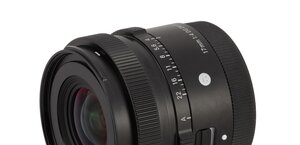Sigma 120-300 mm f/2.8 APO EX DG OS HSM
3. Build quality and image stabilization
In the photo below the tested Sigma is positioned between the Nikkor AF-S 24-70 mm f/2.8 and the Sigma 30 mm f/1.4 EX DC HSM for smaller detectors.
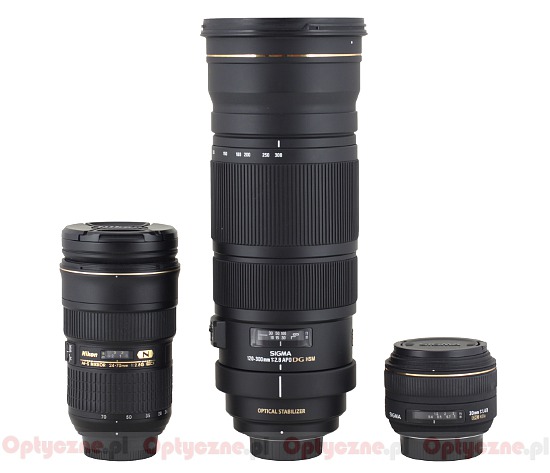 |
Please Support UsIf you enjoy our reviews and articles, and you want us to continue our work please, support our website by donating through PayPal. The funds are going to be used for paying our editorial team, renting servers, and equipping our testing studio; only that way we will be able to continue providing you interesting content for free. |
- - - - - - - - - - - - - - - - - - - - - - - - - - - - - - - - - - - - - - - - - - - - - - - -
The Sigma 120–300 mm f/2.8 APO EX DG OS HSM starts with a metal mount with contacts which surrounds a rear, immobile element. The element, with a diameter of 36 mm, is hidden about 1.5 centimeters deep in the casing.
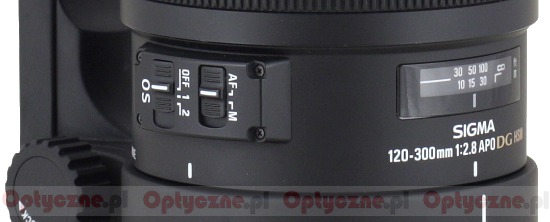 |
On the proper casing you can find first a smooth part with a dot which makes the proper lens alignment with a camera easier. Above it there is an inscription ‘OPTICAL STABILIZER’ which means that an optical image stabilization system was used here. The next element is a place where you can attach a solid tripod, added in the accessory kit. Behind there is an inscription with the name and the parameters of the lens and a bit further you can find a distance scale behind a window, expressed in feet and meters.
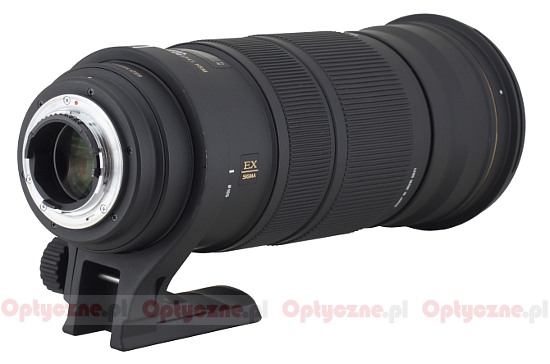 |
On the left side of the scale, looking from above, there are two switches. The first is used to choose the focusing mechanism mode (AF/MF) and the second one – to control the stabilization (OS OFF, 1, 2). The next element is a manual focus ring, 42 mm wide, most of it covered by rubber ribs. The ring moves smoothly and is well-damped so you can be sure of precise settings. Running through the whole scale takes a turn through 130 degrees.
The next part is a very big zoom ring - 73 mm wide. Apart from rubber ribbing it also includes focal length markings for the following values: 120, 150, 180, 200,250 and 300 mm. Then you can find a smooth widening inner tube embellished with a golden stripe; it finishes with a hood mount.
The front element is immobile, 99 mm in diameter. It is also slightly surprising because the exit pupil of the lens, being a combination of the maximum aperture and the maximum focal length, amounts to 107.1 mm. It means at 300 mm you should expect noticeable vignetting.
The front element is surrounded by a non-rotating filter thread with a huge diameter of 105 mm. Taking it into account be prepared to pay through the nose for the filters; it is really a pity the producer didn’t use smaller filters which are put inside close to the rear element.
When it comes to the optical construction we deal here with 23 elements positioned in 18 groups. Two big elements from the previous set are made of fluorite FLD glass. Additionally one element was made of low dispersion SLD glass. Inside the lens you can also find a circular aperture with nine diaphragm blades which can be closed to the value of f/22.
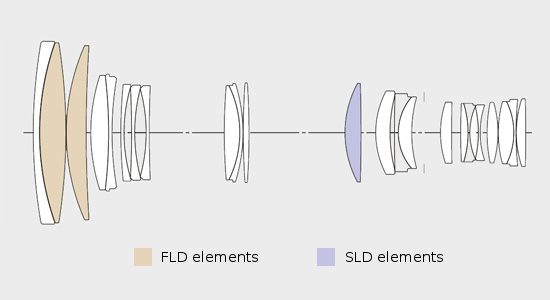
The lens is compatible with Sigma APO series converters but you won’t have any troubles using the original Canon converters as well. The Canon devices don’t fit some of Sigma lenses because their element set sticks out too much but the Sigma 120-300 mm has so much space near the mount that you won’t get any problems here.
In the case of EX series Sigma lenses the producer usually doesn’t stint on accessories; also in the case of this lens buyers are given quite a lot: both caps, a tripod adapter, a hood and a hard case.
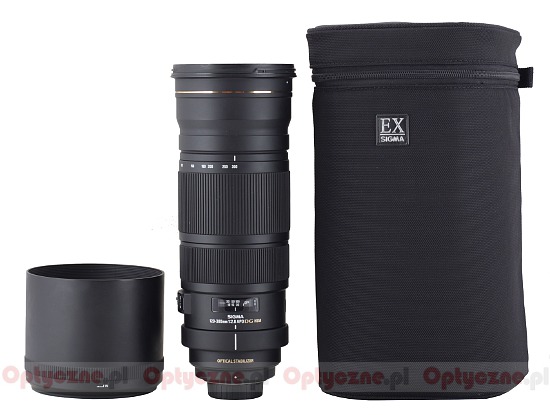 |
Image stabilization
Currently most of stabilized optics producers boast of stabilization as efficient as 4 EV. The Sigma is not an exception to that rule. Still, the results of our stabilization tests are usually lower than the numbers provided by different companies so we were very curious how it would look in the case of the lens presented here, as it belongs to the most expensive devices manufactured by Sigma.
The stabilization test was made at 300 mm. We took several dozen photos with the stabilization switched on and off at every exposure time ranging from 1/320 to 1/3 of a second. Then we determined the percentage of blurred photos. On a graph, presented below, you can find the relationship between fuzzy photos and the exposure time, expressed in EV (where the 0 point is the equivalent of the 1/250 of a second).
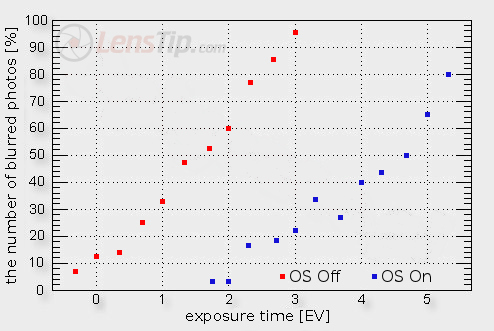
The maximum distance between both curves is our stabilization efficiency measure and in this case it reaches 3 EV. Such a result can be called good but it isn’t brilliant. The Sigma performs worse than other brand name, professional lenses produced by Canon and Nikon which really can reach those declared 4 EV.





